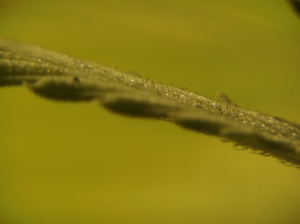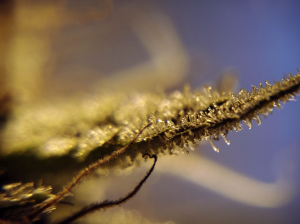What is CBG and why is it the Mother Cannabinoid?

A beginner's guide to Cannabidiol & the Entourage Effect
CBG, or Cannabigerol, is the precursor to all other cannabinoids including THC and CBD. This means that plants in the early stages of development have the highest quantities and as the plant grows the CBG levels lower and other Cannabinoids take its place. However, it is found in all cannabis strains in low levels, and provides no high to the consumer on its own.
ORIGINS
CBG was originally discovered in 1965 by scientists working with hashish. This lead researchers to believe it was a constituent of hash until 1975, when researchers found that the acid form of Cannabigerol (CBGA) occurs naturally as the first cannabinoid to form in a new cannabis plant. Over time the Cannabinoid converts itself into the THC and CBD molecules the plant is best known for today. For this reason it has been dubbed “The Mother Cannabinoid”.
While we once believed that young cannabis plants were the best source for finding Cannabigerol, we have learned in more recent years that CBG converts into THC or CBD relatively quickly in the development process. This means that the best way to find Cannabigerol is to find strains that are known for being high in this cannabinoid. They are rare but they are out there.
SCIENCE
Keep in mind as we delve into some of the science behind each cannabinoid that research on cannabinoids are always done in isolation. The effect of a cannabis or hemp plant on a person will always be the result of hundreds of cannabinoids and terpenes working in conjunction, and will vary from person to person.
In a 2015 study, researchers found that CBG could be helpful for IBS, Huntingtons Disease, and as a potential neuron protector for ailments like Parkinsons Disease. Some studies with mice have also had positive results for colon cancer.
European studies have had positive results with the cannabinoid as an anti-bacterial (specifically staphylococcus), as an appetite stimulant, an analgesic, for cachexia (late stage cancer), issues with bladder/muscle contracts & dysfunctions, and psoriasis- but we will know more when research is complete.
The most common review seen for Cannabigerol is for its help with anxiety, stress relief, and depression. Researchers are currently examining the effects of CBG on PTSD and OCD, but we will know more when research is complete.




HOW TO FIND CBG
Because we have only been able to research the cannabis plant more thoroughly in recent years, Cannabigerol is a relatively new cannabinoid to the cannabis market. That being said, products that are high in Cannabigerol are finally beginning to emerge. East Fork Cultivars recently released their new “The White C B G” flower, which we are proud to have on our shelves at the time of writing this article.
Companies like Mr. Moxey’s Mints, Sun God Medicinals, and Peak Extracts Chocolates have begun to incorporate sub-cannabinoids like Cannabigerol and CBN into their edibles, and Farmer’s Friend Extracts has cartridges and tinctures that feature these cannabinoids heavily. And this is just the beginning- keep your eyes peeled and ask your budtenders about new cannabinoids you are seeing on the shelf!
PRACTICAL USE
Each cannabinoid occurs in different levels within different plants and can interact with each person uniquely depending on the synergy of cannabinoids and terpenes in the plant in combination with how your body produces and reacts to them. Learning about the uses of each cannabinoid can greatly increase your success with using cannabis as a medication. Your budtender can be an excellent tool in helping direct you to the strains and intake methods that are right for you. We only offer Full-Spectrum CBG Products in our store- you can check out our menu here to see what we have available by using the search feature.
In summary

C B G is non-psychoactive on its own, but the effect of cannabis is the result of 100s of cannabinoids and terpenes working in conjunction.
Cannabigerol is the first cannabinoid the cannabis plant makes, but converts to THC and CBD relatively quickly in the cannabis plant.
While research is ongoing, Cannabigerol has shown to have a multitude of potential medical applications.
C B G is newly emerging on the cannabis market, and may be hard to find in flower form but many companies have started to incorporate it into their tinctures, edibles, and cartridges already.
Sourcing
Leafly’s “What is C B G”, https://www.leafly.com/news/cannabis-101/what-is-cbg-cannabinoid
Leafly’s “Is Cannabigerol better than CBD or THC for pain, inflammation, and aging”, https://www.leafly.com/news/strains-products/is-cbg-better-than-cbd-thc-for-pain-inflammation-aging
Weedmaps’ “What is Cannabigerol”, https://weedmaps.com/learn/dictionary/cannabigerol-cbg
Weedmaps’ “CBG vs. CBD: What’s the difference?” https://weedmaps.com/learn/cbd/cbg-vs-cbd
Weedmaps’ “What is CBG? The Minor Cannabinoid with Major Potential” https://weedmaps.com/news/2019/08/what-is-cbg/
Weedmaps’ “What is CBG Oil?” https://weedmaps.com/learn/dictionary/cbg-oil
High Times’ “What is Cannabigerol?” https://hightimes.com/health/science/grow-hack-what-is-cannabigerol-cbg/
High Times’ “Grow Hack: What is Cannabigerol?” https://hightimes.com/health/science/grow-hack-what-is-cannabigerol-cbg/
High Times’ “Learn which Rare Cannabinoid is Best” https://hightimes.com/news/learn-which-rare-cannabinoid-is-best/
High Times’ “The Next Generation of Medicinal Cannabis: CB G” https://hightimes.com/culture/the-next-generation-of-medicinal-cannabis-high-cbg-strains/
High Times’ “CB G & THC-V: The Next Big Cannaboids” https://hightimes.com/sponsored/cbg-thcv-the-next-big-cannabinoids/
High Times’ “The Ultimate Guide to Cannabinoids in Cannabis” https://hightimes.com/guides/cannabinoids/
National Library of Medicine Articles:
“Colon carcinogenesis is inhibited by the TRPM8 antagonist cannabigerol, a Cannabis-derived non-psychotropic cannabinoid”, https://pubmed.ncbi.nlm.nih.gov/25269802/
Borrelli F, Pagano E, Romano B, Panzera S, Maiello F, Coppola D, De Petrocellis L, Buono L, Orlando P, Izzo AA. Colon carcinogenesis is inhibited by the TRPM8 antagonist cannabigerol, a Cannabis-derived non-psychotropic cannabinoid. Carcinogenesis. 2014 Dec;35(12):2787-97. doi: 10.1093/carcin/bgu205. Epub 2014 Sep 30. PMID: 25269802.
“In Vitro Model of Neuroinflammation : Efficacy of Cannabigerol , a Non-Psychoactive Cannabinoid” https://pubmed.ncbi.nlm.nih.gov/29986533/
“Chemotherapy‐induced cachexia dysregulates hypothalamic and systemic lipoamines and is attenuated by cannabigerol” https://www.ncbi.nlm.nih.gov/pmc/articles/PMC6711413/
“Antioxidant and Neuroprotective Effects Induced by Cannabidiol and Cannabigerol in Rat CTX-TNA2 Astrocytes and Isolated Cortexes” https://www.ncbi.nlm.nih.gov/pmc/articles/PMC7279038/
“Neuroprotective Properties of Cannabigerol in Huntington’s Disease: Studies in R6/2 Mice and 3-Nitropropionate-lesioned Mice” https://www.ncbi.nlm.nih.gov/pmc/articles/PMC4322067/
“Cannabigerol is a novel, well-tolerated appetite stimulant in pre-satiated rats” https://www.ncbi.nlm.nih.gov/pmc/articles/PMC5021742/
“Effect of Non-psychotropic Plant-derived Cannabinoids on Bladder Contractility: Focus on Cannabigerol ” https://journals.sagepub.com/doi/pdf/10.1177/1934578X1501000653
“Beneficial effect of the non-psychotropic plant cannabinoid cannabigerol on experimental inflammatory bowel disease” https://www.sciencedirect.com/science/article/abs/pii/S0006295213000543
Development and Modification of Bioactivity” Arno Hazekamp, … Renee L. Ruhaak, in Comprehensive Natural Products II, 2010
“Survey of Patients Employing Cannabigerol-Predominant Cannabis Preparations: Perceived Medical Effects, Adverse Events, and Withdrawal Symptoms” https://www.liebertpub.com/doi/abs/10.1089/can.2021.0058


Leave a Comment